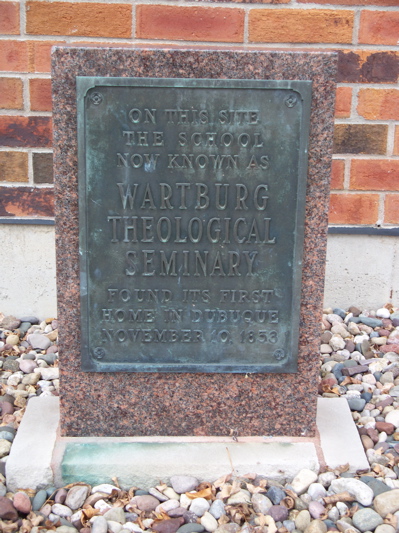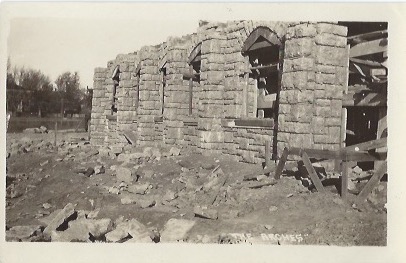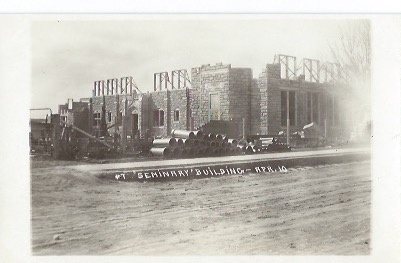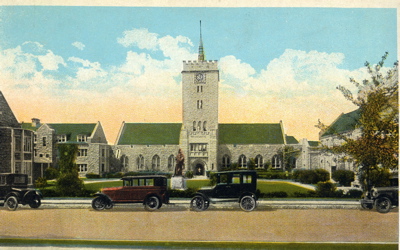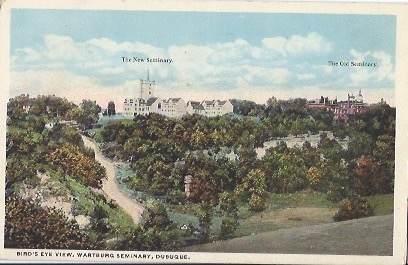Encyclopedia Dubuque
"Encyclopedia Dubuque is the online authority for all things Dubuque, written by the people who know the city best.”
Marshall Cohen—researcher and producer, CNN
Affiliated with the Local History Network of the State Historical Society of Iowa, and the Iowa Museum Association.
WARTBURG THEOLOGICAL SEMINARY: Difference between revisions
No edit summary |
No edit summary |
||
| Line 13: | Line 13: | ||
[[Image:wart1.jpeg|left|thumb|350px|"The Arches." Image courtesy: Larry Friedman]] | [[Image:wart1.jpeg|left|thumb|350px|"The Arches." Image courtesy: Larry Friedman]] | ||
[[Image:wart2.jpeg|left|thumb|450px|Construction in 1915. Image courtesy: Larry Friedman]] | [[Image:wart2.jpeg|left|thumb|450px|Construction in 1915. Image courtesy: Larry Friedman]] | ||
[[Image:wart4.jpeg|left|thumb|350px|"The Arches." Image courtesy: Larry Friedman]]The following years were a time of ever-expanding curriculum and increased enrollment. Plans for new seminary buildings were drawn up in 1914, and construction was begun with stone quarried nearby along Fremont Avenue. The buildings, constructed of Galena limestone to resemble Wartburg Castle in Eisenach, Germany, and the furnishings costing $228,768, were dedicated on September 13-14, 1916. | [[Image:wart4.jpeg|left|thumb|350px|"The Arches." Image courtesy: Larry Friedman]]The following years were a time of ever-expanding curriculum and increased enrollment. Plans for new seminary buildings were drawn up in 1914, and construction was begun with stone quarried nearby along Fremont Avenue. The buildings, constructed of Galena limestone to resemble Wartburg Castle in Eisenach, Germany, and the furnishings costing $228,768, were dedicated on September 13-14, 1916. (6) | ||
Like the original Emerson estate, the construction site of the new buildings was purchased by the citizens of Dubuque and given to Wartburg in support of its efforts. The renowned scholar J. Michael Reu, author of more than sixty books, joined the faculty at this time | Like the original Emerson estate, the construction site of the new buildings was purchased by the citizens of Dubuque and given to Wartburg in support of its efforts. (7) The renowned scholar J. Michael Reu, author of more than sixty books, joined the faculty at this time. Renowned for his nine volume'''Christian Education in Germany from 1530 to 1600,''' he remained in Dubuque for forty-three years. | ||
Married student housing on campus was originally provided by a thirty-six unit mobile home park near the center of campus and a twenty unit apartment building. This was followed by nine single family units constructed for student families with children and then another mobile home park on the southern side of the campus. The mobile homes were to be replaced by Denver Court, a sixteen unit family housing complex. Increased enrollment of students with families, however, led to new trailers being leased to meet housing demands. | |||
[[Image:wartburgcel.jpg|left|thumb|250px|]] | [[Image:wartburgcel.jpg|left|thumb|250px|]] | ||
[[Image:imp907.jpg|left|thumb|350px|Wartburg's construction made it one of the most beautiful sites in Dubuque. Photo courtesy: Bob Reding]]Wartburg has grown through merger with other seminaries. Trinity Theological Seminary (United Evangelical Lutheran Church) from Blair, Nebraska, was moved to Dubuque in 1956 and officially merged with Wartburg in 1960. The seminary | [[Image:imp907.jpg|left|thumb|350px|Wartburg's construction made it one of the most beautiful sites in Dubuque. Photo courtesy: Bob Reding]]Wartburg has grown through merger with other seminaries. Trinity Theological Seminary (United Evangelical Lutheran Church) from Blair, Nebraska, was moved to Dubuque in 1956 and officially merged with Wartburg in 1960. The seminary opened the Denver House of Studies in 1973 and an Hispanic Ministries program in Austin, Texas which required fluency in Spanish. During the 1970s, Wartburg established its international student program which brought church leaders and scholars to the campus for post-graduate theological education. At the time the program was adopted, Wartburg established a commitment to 10% of its on-campus students being from the international church. (8) | ||
Women were ordained for the first time by the Seminary in the 1970s. In 1979 Professor Norma J. Cook joined the faculty and became the first woman given tenure on a seminary faculty in the church. The biographies of women at Wartburg have been told in books entitled ''And The Women Came, 100 And More, and Still The Women Came'' | Women were ordained for the first time by the Seminary in the 1970s. In 1979 Professor Norma J. Cook joined the faculty and became the first woman given tenure on a seminary faculty in the church. The biographies of women at Wartburg have been told in books entitled '''And The Women Came''', '''100 And More''', and '''Still The Women Came.''' In 1989 women accounted for 40 percent of the students and four of the seminary faculty. (9) | ||
Extensive remodeling was carried out in 1982 as a result of a successful church-wide Seminary Appeal | Extensive remodeling was carried out in 1982 as a result of a successful church-wide Seminary Appeal. | ||
In 2013 Wartburg had more than 2,200 alumni serving communities and congregations throughout the United States and 35 countries. ( | In 2013 Wartburg had more than 2,200 alumni serving communities and congregations throughout the United States and 35 countries. (10) | ||
--- | --- | ||
| Line 40: | Line 42: | ||
5. Ibid. | 5. Ibid. | ||
6. "Did You Know?" ''Telegraph Herald'', August 25, 2013, p. 32 | 6. Ibid. | ||
7. Ibid. | |||
8. Ibid. | |||
9. Ibid. | |||
10. "Did You Know?" ''Telegraph Herald'', August 25, 2013, p. 32 | |||
[[Category: Schools/Universities/Colleges]] | [[Category: Schools/Universities/Colleges]] | ||
Revision as of 17:03, 21 February 2018
Being written
WARTBURG THEOLOGICAL SEMINARY. Among the largest Lutheran seminaries in the United States, Wartburg is one of the four theological seminaries owned and operated by the American Lutheran Church.
The history of Wartburg Theolgical Seminary began in November 10, 1853 with the arrival of Sigmund Fritschel. Although only twenty years of age, Fritschel was the would serve the school until just before his death in 1899. In 1856 his brother was installed as the professor of theology. Financial needs forced Sigmund to temporarily accept a pastorate in Detroit. This left his brother Gottfried, then twenty years of age, with the responsibility for the school located on Garfield Street. (1)
Poor economic conditions forced Gottfried to relocate the school to St. Sebald in Clayton County, Iowa in 1857. It was here that the name "Wartburg" was first used. (2) The college and seminary functions were separated in 1868. The college moved to Galena, Illinois, while the seminary remained in St. Sebald. The two parts were reunited in 1874 in Mendota, Illinois. Continued growth required even larger facilities. (3) It was not until 1889 that the seminary moved back to Dubuque. It was through the efforts of Rev. J. Heinrich LUZ and the BOARD OF TRADE that an attractive offer was made. The college moved to Waverly, Iowa.
The home of Wartburg in Dubuque became the thirty-acre Emerson estate with a large mansion that was renovated and enlarged. Two homes for faculty were constructed at 445 and 465 Wartburg Place. The dedication, held on September 15, 1899, saw hundreds of enthusiastic Dubuque residents ride a special train from the Illinois Central rail yard downtown to the campus to welcome the seminary back to the community. (4)
With room for expansion and the support of the community, Wartburg Seminary hired additional faculty. Among these were the second generation of Fritschels. Sigmund had returned to the school and he was joined by his son Max. Gottfried was joined by his son, George who like Max accepted seminary leadership and faculty positions. Both served the school for more than three generations. (5)
The following years were a time of ever-expanding curriculum and increased enrollment. Plans for new seminary buildings were drawn up in 1914, and construction was begun with stone quarried nearby along Fremont Avenue. The buildings, constructed of Galena limestone to resemble Wartburg Castle in Eisenach, Germany, and the furnishings costing $228,768, were dedicated on September 13-14, 1916. (6)
Like the original Emerson estate, the construction site of the new buildings was purchased by the citizens of Dubuque and given to Wartburg in support of its efforts. (7) The renowned scholar J. Michael Reu, author of more than sixty books, joined the faculty at this time. Renowned for his nine volumeChristian Education in Germany from 1530 to 1600, he remained in Dubuque for forty-three years.
Married student housing on campus was originally provided by a thirty-six unit mobile home park near the center of campus and a twenty unit apartment building. This was followed by nine single family units constructed for student families with children and then another mobile home park on the southern side of the campus. The mobile homes were to be replaced by Denver Court, a sixteen unit family housing complex. Increased enrollment of students with families, however, led to new trailers being leased to meet housing demands.
Wartburg has grown through merger with other seminaries. Trinity Theological Seminary (United Evangelical Lutheran Church) from Blair, Nebraska, was moved to Dubuque in 1956 and officially merged with Wartburg in 1960. The seminary opened the Denver House of Studies in 1973 and an Hispanic Ministries program in Austin, Texas which required fluency in Spanish. During the 1970s, Wartburg established its international student program which brought church leaders and scholars to the campus for post-graduate theological education. At the time the program was adopted, Wartburg established a commitment to 10% of its on-campus students being from the international church. (8)
Women were ordained for the first time by the Seminary in the 1970s. In 1979 Professor Norma J. Cook joined the faculty and became the first woman given tenure on a seminary faculty in the church. The biographies of women at Wartburg have been told in books entitled And The Women Came, 100 And More, and Still The Women Came. In 1989 women accounted for 40 percent of the students and four of the seminary faculty. (9)
Extensive remodeling was carried out in 1982 as a result of a successful church-wide Seminary Appeal.
In 2013 Wartburg had more than 2,200 alumni serving communities and congregations throughout the United States and 35 countries. (10)
---
Source:
1. "Wartburg Seminary: A Short Story," Telegraph Herald Wartburg Section, September 16, 1989, p. 17
2. Ibid.
3. "Heritage," Wartburg Theological Seminary, Online: https://www.wartburgseminary.edu/heritage/
4. "Wartburg Seminary..."
5. Ibid.
6. Ibid.
7. Ibid.
8. Ibid.
9. Ibid.
10. "Did You Know?" Telegraph Herald, August 25, 2013, p. 32


